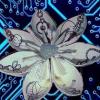The Nicholson School
The Nicholson School, located in the Port Regal neighborhood in Freedom City, is a small private academy for children from kindergarten to eighth grade. Attendance is limited and extremely difficult to come by, though the student body shows a wide mix of backgrounds and nationalities. Theschool is semi-residential and runs all year on a system of quarters with three-week breaks in-between. Its headmaster is Christina Wheeler, a Harvard graduate in finance who retired from a lucrative position on Wall Street to take on the responsibility.
The school works hard to maintain its veneer of anonymous respectability, the better to conceal its secrets. Like the Claremont Academy to which it feeds, Nicholson is populated entirely by students of extranormal origin. When Duncan Summers took over Claremont Academy in the wake of the Terminus invasion, it was assumed that there were not sufficient numbers of superpowered children to warrant the establishment of a lower school. The United States government thought otherwise, and were in fact able to secure a population of so-called “Terminus Babies” for supervision and training in their own program. The government program was widely considered a debacle, despite scattered successes, and was eventually dissolved, but the need for superhuman schooling continued.
Plans for a lower school in the same vein as Claremont remained on the drawing board for years, due to the substantial logistical difficulties entailed in the primary education of superhuman children. Unlike high schoolage students, who could be presumed to be ready for a modicum of independence, most primary schoolchildren required and desired close parental contact and supervision. Parents, too, would be less willing to allow their young children to be taken away for schooling, no matter how dangerous their powers and how attentive the school personnel. Accommodations would have to be made for entire families to be moved and housed near the school. The range of ages and developmental stages at the new school would also be much wider than at Claremont, requiring an entirely different educational model. Though the school was regarded as an excellent idea in theory by much of the super-community, it languished for lack of a dedicated leader to put plan into action.
In 2003, Joshua Wheeler, son of Christina and Roger Wheeler, made headlines in New York City when he lifted and threw a car that was pinning a pedestrian at an accident site. This was not wholly newsworthy in New York, which has a fair share of superheroes, but for the fact that Joshua was only four years old at the time. His parents, retired heroes themselves, were surprised at the early onset of their offspring's powers, and immediately began looking for an appropriate place where their special child could receive training and education. Upon realizing that there was nothing available, Christina, whose enhanced intelligence and charisma had made her a formidable force in business, turned her attention to becoming an educator. Barely a year later, The Nicholson School was founded in Freedom City, a superhero hotbed where no one had heard of Joshua Wheeler. Enrollment in the first year was very small, barely a dozen students across the entire range of grades. As word of the new school spread to those who needed it, though, enrollment began to grow. A unique educational program, Nicholson now draws students and families from around the world to its Port Royal enclave.
Layout
The physical property of The Nicholson School consists not only of its education building, but also a dormitory for boarding students and a collection of several dozen private homes dubbed the “family village.”
Education Building
The Nicholson School itself is contained in one large three-story building, specially constructed for the purpose in 2005. The education building combines cutting-edge safety technology to render it impervious to most physical threats with state-of-the-art understanding of optimal school layout. The classrooms are large and airy, each with at least one wall of adjustably-tinted windows to provide natural light and visual stimulation for students. Every classroom is wired for comprehensive internet connectivity, with security that renders the network as safe as any other part of the building. The second floor is entirely devoted to classrooms, with multipurpose rooms on the first and third floors that can be converted as need allows.
The third floor is devoted mainly to non-classroom-based education. Science labs for physics, chemistry and engineering are all located here, as well as an art studio and a music room. The school library is also located on the third floor.
The school's first floor contains all the administrative offices, as well as the cafeteria and gymnasium. The gymnasium doubles as a training facility for students, so is specially reinforced to withstand extreme forces. The gym equipment is likewise reinforced to prevent accidents and damage. The school cafeteria provides two meals a day and is capable of coping with a mind-boggling variety of dietary restrictions. The area behind the school houses playground equipment, a baseball diamond and a grassy area for games, and a paved track.
Dormitory
A few hundred yards from the school is the dormitory building, a smaller three-story building constructed in the same style as the school itself. Designed for the small population of students who do not live with their families for whatever reason, the dormitory can hold up to a hundred students but generally has fewer than thirty at any given time. Boys are housed on the third floor, girls on the second, with common areas on the first. The first floor of the dormitory houses the school infirmary, a cafeteria that handles dinners, weekends and vacations in a manner designed to be more homelike than the one in the education building, visitors' quarters, and common playrooms and multimedia room.
The bedrooms themselves are not dissimilar to what students who move on will find at Claremont. Each one has two beds, two dressers, two desks, and two closets, along with one or two broad windows. Despite the surplus of space, rooms are double-occupancy in most cases to provide students with peer companionship. Rooms are staggered from east to west, with the youngest students in the eastern rooms and older ones heading westward along the corridor. Each floor has several communal bathrooms, the easternmost of which is height-adjusted for the younger students. In addition to student housing, the dormitory also provides housing for the adult caregivers who work with the children outside of school hours. School policy mandates one adult for every four children under ten years old, or one per six children ten to fourteen. Adult caregivers live in quarters resembling one-bedroom apartments in the dormitories and function as surrogate parents, authority figures, and coordinators for all the activities and evaluations of their young charges. The job pays well, but the pressure can become intense and staff turnover is high. Many adult caregivers are young adult metahumans in their first paid jobs.
Family Village
The square block of housing surrounding the Nicholson campus proper is also owned by the school. Known as “Family Village,” it consists mainly of single-family dwellings and duplexes, each one inhabited by a schoolfamily. Any family with a student at Nicholson is eligible to move into the Family Village, with rent determined on a sliding scale according to financial need. The Nicholson Parent Teacher Association serves as a de facto neighborhood committee as well, welcoming new arrivals and organizing events throughout the year. The PTA is also responsible for maintaining the low profile of the neighborhood when it comes to displays of superpowered activity. For all Freedom City is no stranger to strange events, nobody wants too much attention focused on the school and its environs.


